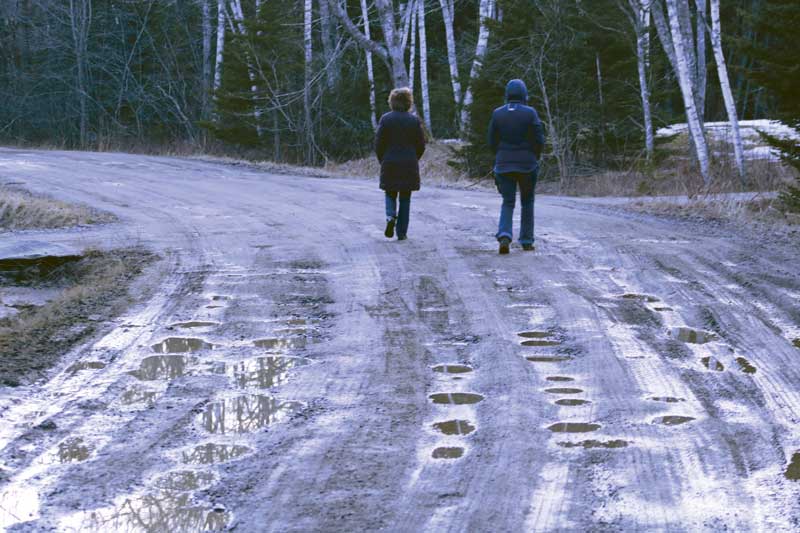 After a winter spent cooped-up indoors, walking down a road—even a muddy and rutted one—can have surprising appeal. Photo courtesy Mark Pillsbury
After a winter spent cooped-up indoors, walking down a road—even a muddy and rutted one—can have surprising appeal. Photo courtesy Mark Pillsbury
Along the Maine Coast as winter turns toward spring, the interval between the last flake and the first daisy defines the state’s essence. If you want sand go to Arizona, but if you want mud come to Maine. A trip to the woodshed across the sticky stuff becomes an epic journey plastering the soles of our shoes so resolutely that when you’re back at the house with an armload of firewood, you’re taller than when you went out in the first place.
I don’t visit my friends out on gooey roads in mud time out of fear my truck will bottom-out in the primal ooze and I’ll be stuck there ’til the Fourth of July. “Getting up over March Hill” is the way locals define the season, and the hill isn’t getting any shorter with climate change turning winter into spring earlier every year.
March is not a great time to be the oil truck driver struggling down flooded dirt roads and wrestling his heavy hose to fill tanks before they run dry. It’s not a great time to be a carpenter hoping to get a building job started so he can finish it before the snow flies the following fall. Yet in spite of such travails, a lot of us have grown to love Mud Time.
It’s the moment pussy willows appear out of nowhere, their fuzzy overcoats keeping them snug against the vagaries of frost and sleet that are a signature of March days. For the first time since late October, the sun’s warmth actually does some good on the back of my neck. On one of those early spring drives to check out the new season, I’ll probably see some old guy just standing alone in his yard looking out in the distance for the change of season he hopes will come. Although spring is painfully slow in arriving, soon the grass will green up, geese will honk overhead, bullfrogs will harrumph in the shallows of the pasture pond, and if I’m lucky, a bluebird might land on a twig, the same as last year.
In New England, mud time is a dynamic season. As Robert Frost put it in his poem “Two Tramps in Mud Time”:
The sun was warm but the wind was chill.
You know how it is with an April day
When the sun is out and the wind is still,
You’re one month on in the middle of May.
But if you so much as dare to speak,
A cloud comes over the sunlit arch,
And a wind comes off a frozen peak,
And you’re two months back in the middle of March.
Without question L.L. Bean knows all about mud. Its rubber-soled hunting shoes, designed by Mr. Bean himself, have been popular with teenagers and adults alike for over a century. But Bean Boots, as they are known, are not designed for wading through standing water—the rubber soles don’t go high enough for that. Instead, they are designed to get a hunter across rough country. March country. Mud country. If the right boots can help a hunter keep his balance through sloppy conditions while carrying a gun, his day in the woods is going to go a lot better.
Most of us have dealt with a variety of mud-time situations. On top of these, are mud-time apocalypses.
The one I remember came in the early spring of 1969. The winter before had been severe. Four or 5 feet of snow piled up from Christmas to Groundhog Day, when the thaw came with sudden ferocity: a monstrous rain storm melting the snow and causing water to pour over the frozen ground straight into my ancient basement.
Naturally, Murphy’s Law came to life. The cellar drain outflow was frozen tight from the harsh winter, and to try clearing it, I stripped down to my shorts and plunged in hoping I could free things up.
No luck. But I was younger then and miraculously avoided going into cardiac arrest, swimming around in the chest-high snowmelt. Ultimately it took a neighbor’s 5-hp pump to get the water level down low enough so I could unhook the furnace motor and the well pump motor, dry them out in the oven, and return life to somewhere near normal.
The basement had always had a battle-scarred look to it, as if it had been flooded many times over the years. How the previous owners—a couple who had lived in the house into their mid-90s—had dealt with situations like this, I’ll never know.
The next summer I took charge of the problem, digging a ditch to divert run-off and installing a proper cellar drain.
A few years later when I built a new house in a new town, I made sure that my cellar would stay water-free, no matter how wet things got outside. As my friend the builder, Jimmy Steele, said, “We’ll make it so dry you can strike a match anywhere on the foundation.” And 40 years later, you still can.
When it’s all said and done, the adventure of springtime along the Maine Coast with its deluge of mud will come and go, but with good boots and a good foundation, life will go on for me tight, warm, and bone dry.
✮
Bill Mayher lives in Brooklin, Maine, and is one of the founders of offcenterharbor.com.






